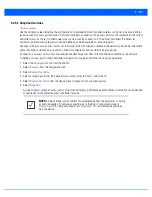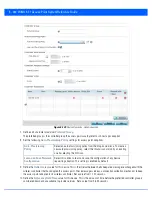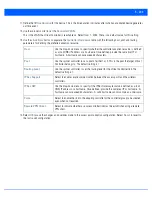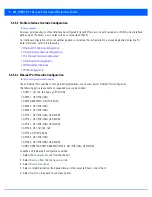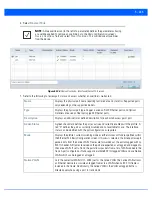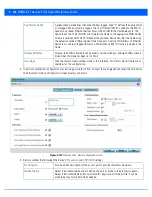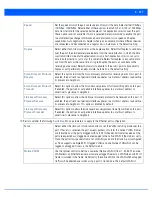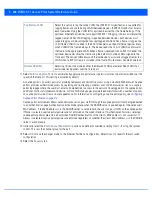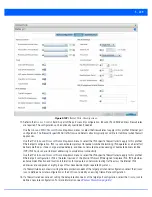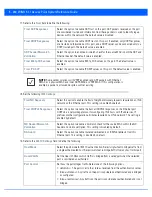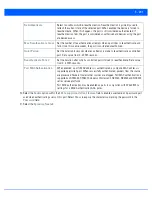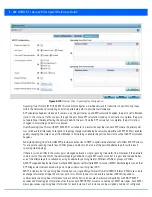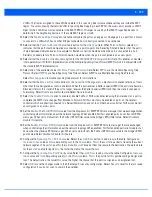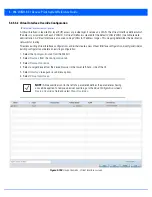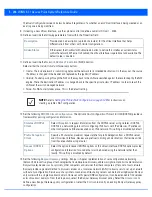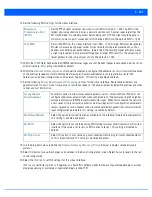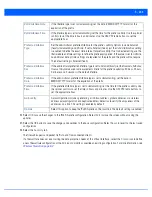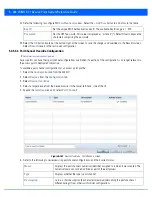
5 - 232 WiNG 5.7.1 Access Point System Reference Guide
Figure 5-149
Ethernet Ports – Spanning Tree Configuration
Spanning Tree Protocol
(STP) (IEEE 802.1D standard) configures a meshed network for robustness by eliminating loops
within the network and calculating and storing alternate paths to provide fault tolerance.
STP calculation happens when a port comes up. As the port comes up and STP calculation happen, the port is set to Blocked
state. In this state, no traffic can pass through the port. Since STP calculations take up to a minute to complete, the port is
not operational thereby effecting the network behind the port. Once the STP calculation is complete, the port’s state is
changed to Forwarding and traffic is allowed.
Rapid Spanning Tree Protocol
(RSTP) (IEEE 802.1w standard) is a evolution over the standard STP where the primary aim
was to reduce the time taken to respond to topology changes while being backward compatible with STP. PortFast enables
quickly changing the state of a port from Blocked to Forwarding to enable the port to allow traffic while the STP calculation
happens.
Multiple Spanning Tree Protocol
(MSTP) provides an extension to RSTP to optimize the usefulness of VLANs. MSTOP allows
for a separate spanning tree for each VLAN group, and blocks all but one of the possible alternate paths within each
spanning tree topology.
If there is just one VLAN in the access point managed network, a single spanning tree works fine. However, if the network
contains more than one VLAN, the network topology defined by single STP would work, but it is possible to make better
use of the alternate paths available by using an alternate spanning tree for different VLANs or groups of VLANs.
A MSTP supported deployment uses multiple MST regions with multiple MST instances (MSTI). Multiple regions and other
STP bridges are interconnected using one single
common spanning tree
(CST).
MSTP includes all of its spanning tree information in a single
Bridge Protocol Data Unit
(BPDU) format. BPDUs are used to
exchange information bridge IDs and root path costs. Not only does this reduce the number of BPDUs required to
communicate spanning tree information for each VLAN, but it also ensures backward compatibility with RSTP. MSTP
encodes additional region information after the standard RSTP BPDU as well as a number of MSTI messages. Each MSTI
messages conveys spanning tree information for each instance. Each instance can be assigned a number of configured
Summary of Contents for WiNG 5.7.1
Page 1: ...WiNG 5 7 1 ACCESS POINT SYSTEM REFERENCE GUIDE ...
Page 2: ......
Page 3: ...WING 5 7 1 ACCESS POINT SYSTEM REFERENCE GUIDE MN001977A01 Revision A April 2015 ...
Page 4: ...ii WiNG 5 7 1 Access Point System Reference Guide ...
Page 24: ...1 4 WiNG 5 7 1 Access Point System Reference Guide ...
Page 36: ...2 12 WiNG 5 7 1 Access Point System Reference Guide ...
Page 72: ...3 36 WiNG 5 7 1 Access Point System Reference Guide ...
Page 470: ...5 386 WiNG 5 7 1 Access Point System Reference Guide ...
Page 472: ...6 2 WiNG 5 7 1 Access Point System Reference Guide Figure 6 1 Configuration Wireless menu ...
Page 624: ...7 46 WiNG 5 7 1 Access Point System Reference Guide ...
Page 724: ...9 56 WiNG 5 7 1 Access Point System Reference Guide ...
Page 783: ...12 35 Figure 12 46 Device Summary screen 4 Click File Management ...
Page 816: ...12 68 WiNG 5 7 1 Access Point System Reference Guide ...
Page 1006: ...13 190 WiNG 5 7 1 Access Point System Reference Guide ...
Page 1026: ...14 20 WiNG 5 7 1 Access Point System Reference Guide ...
Page 1028: ...A 2 WiNG 5 7 1 Access Point System Reference Guide ...
Page 1089: ......
Page 1090: ...MN001977A01 Revision A April 2015 ...




